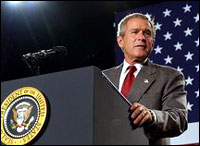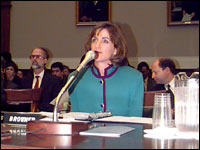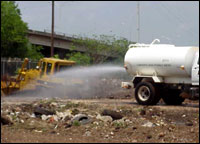
Bush talks to the masses in Michigan.
Photo: White House.
When President Bush set out on Monday to defend his recent New Source Review rollback and promote his energy bill and Clear Skies program, it was hard not to notice the peculiar setting he chose. Wearing a hardhat and safety glasses, the commander in chief mingled with a crowd of begoggled workers at a hulking dinosaur of a power plant in Monroe, Mich. Built in 1970, the facility is the second largest coal-fired plant in the United States — and one of the dirtiest, emitting 91,964 tons of sulfur dioxide, 41,624 tons of nitrogen oxide, and 810 pounds of mercury every year.* Moreover, its owner, Detroit Edison, is currently being investigated by the federal government for illegally increasing air pollution by upgrading its plants without NSR permits or pollution controls. (It remains to be seen whether the investigation will continue now that NSR has been relaxed, but since the inquiry began before the rollback, technically it should go on.)
“Why pick a company with a bad track record? Why pick one of the dirtiest plants in the country that has no plans to clean up and that the [Clear Skies] proposal wouldn’t require to do any cleaning up?” asked Eric Schaeffer, former civil enforcement chief for the EPA and current director of the Environmental Integrity Project. Why not pick a plant or company that was in the process of installing a scrubber? Why not pick a brand new plant with state-of-the-art emissions controls? Why not go, for instance, to the Wisconsin Electric Power Co. facility next door, which has actually settled with the government and is conducting a significant cleanup?
The answer is frighteningly simple: campaign strategy. Bush lost Michigan to Al Gore in 2000, a major blow, and it will be a critical state in 2004. (So will Pennsylvania, which Bush also lost in 2000, and where he headed immediately after his Monroe visit for a fundraising event to add to his $63 million grubstake for the ’04 election.) Michigan is also an industrial state that has suffered considerable job losses and a significant recession in recent years, so the Bush team figured workers would be receptive to the president’s promises that his NSR rollback and energy bill would boost the economy. “The rules created too many hurdles, and that hurts the working people,” said Bush. “It makes sense to change these regulations. It makes sense for the workplace environment.”
The blackout was also a hot-button issue in Michigan, which saw mighty Detroit plunge into darkness, and it made for a perfect excuse to push the Bush administration’s energy bill. “Lights went out last month — you know that. It might have been good for candle sales, but it certainly wasn’t good for job growth,” said Bush to roars of laughter. “My [energy] plan modernizes — calls for the modernization of the electricity grid.”
From the standpoint of the EPA, the trip was also a much-needed excuse to shift the public debate on air policy away from two recent, shocking reports — one from the EPA’s inspector general, which charged the agency with covering up news of potentially deadly contaminants in the air at Ground Zero after Sept. 11, 2001, and another from the General Accounting Office which dismissed the evidence on which the NSR rollback was based as “anecdotal.” Small wonder the Bush admin would prefer to focus on the seemingly more benign issue of Clear Skies.
Put Your Best Soot Forward

Browner defends the crackdown on
particulate pollution in the House in 1997.
Photo: U.S. House of Representatives.
With all the clean-air controversies swirling about these days, it’s not surprising that one slipped through the cracks last month — even though it happens to be the sequel to one of the most explosive air-quality controversies in recent history. Remember back in 1997, when then-EPA Administrator Carol Browner went all the way to the Supreme Court to defend efforts to crack down on small particle pollution? It was not exactly a popular cause inside the Beltway, or the Rust Belt: Industry lawyers, the Clinton administration’s Energy Department, Commerce Department, Treasury Department, and White House economic advisors all lined up against her. “Everyone said that civilization as we know it would come to an end if we had these tougher air standards,” said Frank O’Donnell, executive director of Clean Air Trust. “They dismissed the basis for Browner’s standards as ‘junk science.'”
Not only did Browner eventually win (and civilization as we know it fail to end), but also the Bush EPA released a 400-page report late last month revealing that recent scientific studies “confirmed and strengthened” the association between exposure to microscopic soot and premature deaths, heart problems, asthma, lung cancer, and emphysema. The studies show more than a few examples of harmful health effects even when soot concentrations were well below the maximum allowed by the 1997 standard, and go so far as to recommend that the soot limits be further reduced, perhaps by as much as 50 percent. Tell that to the industry lawyers!
Or not. “This is something that is probably a major embarrassment to the Bush administration, since the emphasis of their policy has been to weaken the actual pollution controls,” said O’Donnell. “I would not at all be surprised if this gets censored in the next edition of the paper, which goes final sometime next year.”
Not-So-Superfund
On Monday, Public Employees for Environmental Responsibility got its hands on a memo sent by the EPA’s CFO Linda Combs to Acting Administrator Marianne Horinko. In it, Combs expressed concern about major cuts to programs such as Superfund in the Senate version of the agency’s proposed budget for fiscal year 2004: “Despite the increase to the over-all Agency [budget] total, the prospects for our core programs are sobering.”

Money is disappearing for Superfund
cleanups like this one in Louisiana.
Photo: U.S. EPA.
EPA spokesperson Philip Angell immediately blamed Senate Democrats, telling Washington Post reporter Eric Pianin that “it’s ironic … but not unexpected” that the Dems joined with Republicans in voting against a proposed increase in Superfund spending after repeatedly complaining that the administration has been too slow on Superfund cleanups.
Chris Miller, a staffer at the Senate Environment and Public Works Committee, which is responsible for seeing the budget proposal through, told Grist that it was “patently ridiculous to imply that Democrats are trying to unfund Superfund.” Senate Dems have been supporting an extension of the Superfund tax for years now; the resistance has clearly been coming from the GOP. It’s the dwindling industry-financed Superfund trust fund — which fell from $3.6 billion in 1995 to a projected $28 million this year — that is responsible for the major plunge in cleanups in the past two years, said Miller, not this baloney about budget appropriations. Annual cleanups have dropped from a high of about 85 sites per year during the Clinton administration to about 45 since Bush took office.
According to Jeff Ruch, executive director of PEER, it turns out that Democrats didn’t really have much say over what got cut from the appropriations bill in the first place. “Unlike the way it’s traditionally done, the cuts were not debated in subcommittee. Everybody agreed that $750 million dollars of congressional projects should be added. In order to get this bill moving quickly, they did a procedural short circuit, allowing the Republican chairman [Sen. James Inhofe (R-Okla.)] to decide where the compensatory cuts would go.” Ruch emphasizes, however, that the Senate version of the EPA budget is still on the floor, so it’s not too late to reverse the changes.
*[Correction, 19 Sep 2003: This article originally stated that the Monroe plant emitted 102,700 tons of sulfur dioxide and 45,900 tons of nitrogen oxide annually. In fact, 2002 EPA figures show the plant emits 91,964 tons of sulfur dioxide and 41,624 tons of nitrogen oxide.]

